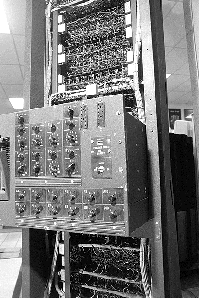This first computer used modern digital switching techniques and vacuum tube switches along with introducing the concepts of logic circuits and binary arithmetic.
They named this first computer after themselves and it was called the Atanasoff Berry Computer or simply ABC.
An interesting tidbit surrounding the first electronic computer is that Atanasoff’s and Berry’s creation was legally only official on Oct 19, 1973 if you can believe that. This official branding of creating the first electronic computer followed a long court trial where U.S Federal Judge Earl Larson voided the ENIAC patent of Mauchly and Eckert and named Atanasoff and Berry as the official inventor of the first electronic computer system.
In 1943 Alan Turing completed a secret code breaking computer called the Colossus for the British to decode German secret messages during World War II. This project was however kept secret many years after the war and thus his work was not as credited as it would have been if known during the war.
The military was a huge driving force for electronic computer devices, and in fact they needed systems beyond code breaking computers including those used for weapon trajectory calculations and more.
The birth of the Electrical Numberical Integrator and Calculator (E-N-I-A-C)
 Come 1946 two men named John Eckert and John Mauchly built the first large scale electronic computer for the military. This machine came out of the Moore School of Electrical Engineering at the University of Pennsylvania and it became known as the ENIAC or Electrical Numerical Integrator and Calculator.
Come 1946 two men named John Eckert and John Mauchly built the first large scale electronic computer for the military. This machine came out of the Moore School of Electrical Engineering at the University of Pennsylvania and it became known as the ENIAC or Electrical Numerical Integrator and Calculator.
E-N-I-A-C operated on 10 digit numbers and could actually multiply two numbers at a rate of 300 products per second by the values of each product stored in a multiplication table in its memory. The E-N-I-A-C computer at the time was approximately one thousand times faster than older electromechanical relay switched computers.
Check this, E-N-I-A-C occupied 1,800 square feet of space. How would you like a computer system that required a large house to accommodate it? Let’s call ourselves lucky and continue to enjoy our digital gluttony lifestyles. Another interesting fact is that E-N-I-A-C used approximately 18,000 vacuum tubes also, and it required about 180,000 watts of electrical juice to operate. That’s 4,500 40-watt modern light bulbs folks. Crazy!
For input and output the E-N-I-A-C relied on punched cards, and registers served as quick access read and write storage. Each program was created by specific wiring and switches that controlled the flow of calculations through the computer. Because of this the ENIAC had to be rewired and switched for each program to run.
As we briefly mentioned earlier Eckert and Mauchly were rewarded the patent for the first electronic computer until it was voided and awarded to Atanasoff and Berry. See a mathematician named John von Neumann in 1945 demonstrated that a computer could have a fixed physical structure and still have the capability of executing any type of calculation effectively by means of correct programmed control without the need for changing hardware. Basically this meant that you can change a program without rewiring the entire system. It is known as the stored program technique and it was Neumann’s demonstration and ideas of this that became the fundamental backbone for future generations of high speed digital computer systems. Pretty cool!
Return to: